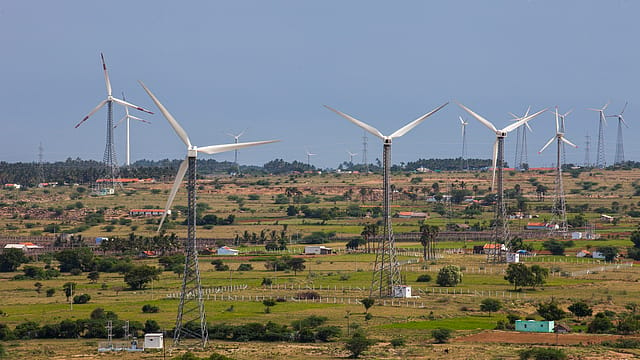Replacement of old windmills is ₹40,000 crore opportunity
ADVERTISEMENT

The Ministry of New and Renewable Energy's (MNRE) move to repower old wind power plants with more height and better efficient windmills could potentially attract ₹40,000 crore of investments and speed up a slowing down wind energy industry in the country. The move will also help to replace about 5 gigawatt (GW) of old wind power plants, especially in Gujarat and Tamil Nadu, estimate experts.
The move will kickstart investments worth ₹40,000 crore (including the cost of acquiring and dismantling old plants) over 3-5 years, nearly 3x the average annual wind power capex seen in the past four fiscals, says a CRISIL analysis. The MNRE had come up with a draft notification - National Repowering Policy for wind power projects on October 17, 2022, as part of efforts to solve the issue of slowing down capacity addition in wind energy in the country.
Wind power capacity additions began in India over two decades ago, driven by the government's supportive policies of accelerated depreciation and feed-in tariff, and availability of sites with high generation potential. Total installed capacity nearly tripled from 13 gigawatt (GW) in 2010 to 34 GW till March 2018. But most of these entailed windmills with hub height less than 100 metres, and narrower turbines of less than 1.5 megawatt (MW) capacity. They generate less per unit of capex compared with newer technologies.
January 2026
Netflix, which has been in India for a decade, has successfully struck a balance between high-class premium content and pricing that attracts a range of customers. Find out how the U.S. streaming giant evolved in India, plus an exclusive interview with CEO Ted Sarandos. Also read about the Best Investments for 2026, and how rising growth and easing inflation will come in handy for finance minister Nirmala Sitharaman as she prepares Budget 2026.
The country added just 1.45 GW of wind capacity in 2021 to have about 40 GW capacity, 20 GW lower than the end 2022 target. As of 22-11-2022, India's wind capacity was 41.8 GW. India targets to have 150 GW of wind by 2030, which means need to add 18-20 GW a year from now onwards. In FY17, India had added the highest ever 5.5GW of wind energy capacity. India has a gross wind power potential of 302 GW, estimates the Government.
But since 2017, new projects declined mainly due to a policy change - introduction of e-reverse auctions or projects awarded based on lowest bidding to boost competition. But that backfired as many bidders refrained from bidding for unviable projects. Other reasons for this slowdown has been shortage of wind sites with high generation potential leading to higher capital cost per unit of generation compared with solar projects.
In current circumstances, it will be viable only if tariffs are around ₹3.3 to ₹3.5 per unit and that require policy and regulatory changes, PKC Bose, chairman and managing director, Enercon India, the Indian arm of German wind turbine major Enercon GMBH, had told Fortune India in an recent interaction.
Under the new policy, new windmills can operate at hub heights over 150 metres and generate more electricity per unit of machine capex using turbines of over 3 MW capacity. This can leverage high-generation-potential sites that now have the older generation turbines. For instance, a new 3 MW windmill with a plant load factor (PLF) of 34-36% can potentially generate 200% more electricity versus a one MW old machine at the same site with a PLF of 22-24%.
"This may lead to replacement of 5 GW of old windmills with new wind power plants with 2x more generation ability. Their viability looks good because such projects can generate double-digit returns at tariffs of ₹4 per unit for the incremental capacity. Such a tariff can attract customers through open access, because their average power purchase cost today is ₹4-5 per unit (net of cross subsidy and transmission charges)," says Ankit Hakhu, director, CRISIL Ratings. The policy provides clarity on extending eligibility of older machines from 1 GW to 2 GW to be repowered, on sale of incremental generation under open access route and aggregation of projects (helping pool contiguous land parcels/ projects, says Varun Marwaha, associate director, CRISIL Ratings.
Capital expenditure per MW will be higher for repowering than greenfield projects because developers acquiring old wind sites would likely pay a premium and also incur dismantling expenses of ₹80 lakh to ₹1 crore per MW. While generation will increase by 200–300%, the projects may still need higher tariffs (Rs 4 per unit) than the recently discovered bids of ₹3 per unit to generate double-digit returns, says CRISIL.
Commercial and industrial customers will find ₹4 per unit tariffs lucrative compared with grid tariffs of ₹7-8 per unit in Gujarat and Tamil Nadu. Developers could prefer repowering than setting up greenfield solar or wind capacity because the risks would be lower given the proven generation track record of existing wind sites. Additionally, evacuation infrastructure would already exist, including right-of-way and feeders at grid substations, says CRISIL.
